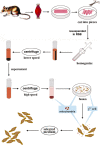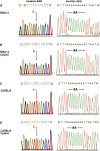Generation and bioenergetic analysis of cybrids containing mitochondrial DNA from mouse skeletal muscle during aging
- PMID: 20022917
- PMCID: PMC2847227
- DOI: 10.1093/nar/gkp1162
Generation and bioenergetic analysis of cybrids containing mitochondrial DNA from mouse skeletal muscle during aging
Abstract
Mitochondrial respiratory chain defects have been associated with various diseases and normal aging, particularly in tissues with high energy demands including skeletal muscle. Muscle-specific mitochondrial DNA (mtDNA) mutations have also been reported to accumulate with aging. Our understanding of the molecular processes mediating altered mitochondrial gene expression to dysfunction associated with mtDNA mutations in muscle would be greatly enhanced by our ability to transfer muscle mtDNA to established cell lines. Here, we report the successful generation of mouse cybrids carrying skeletal muscle mtDNA. Using this novel approach, we performed bioenergetic analysis of cells bearing mtDNA derived from young and old mouse skeletal muscles. A significant decrease in oxidative phosphorylation coupling and regulation capacity has been observed with cybrids carrying mtDNA from skeletal muscle of old mice. Our results also revealed decrease growth capacity and cell viability associated with the mtDNA derived from muscle of old mice. These findings indicate that a decline in mitochondrial function associated with compromised mtDNA quality during aging leads to a decrease in both the capacity and regulation of oxidative phosphorylation.
Figures






Similar articles
-
Comparative bioenergetic study of neuronal and muscle mitochondria during aging.Free Radic Biol Med. 2013 Oct;63:30-40. doi: 10.1016/j.freeradbiomed.2013.04.030. Epub 2013 Apr 30. Free Radic Biol Med. 2013. PMID: 23643721 Free PMC article.
-
Loss of the antioxidant enzyme CuZnSOD (Sod1) mimics an age-related increase in absolute mitochondrial DNA copy number in the skeletal muscle.Age (Dordr). 2016 Aug;38(4):323-333. doi: 10.1007/s11357-016-9930-1. Epub 2016 Jul 21. Age (Dordr). 2016. PMID: 27444179 Free PMC article.
-
Concentration of mitochondrial DNA mutations by cytoplasmic transfer from platelets to cultured mouse cells.PLoS One. 2019 Mar 4;14(3):e0213283. doi: 10.1371/journal.pone.0213283. eCollection 2019. PLoS One. 2019. PMID: 30830936 Free PMC article.
-
Respiratory function decline and DNA mutation in mitochondria, oxidative stress and altered gene expression during aging.Chang Gung Med J. 2009 Mar-Apr;32(2):113-32. Chang Gung Med J. 2009. PMID: 19403001 Review.
-
The role of mitochondrial DNA mutations in aging and sarcopenia: implications for the mitochondrial vicious cycle theory of aging.Exp Gerontol. 2008 Jan;43(1):24-33. doi: 10.1016/j.exger.2007.10.001. Epub 2007 Oct 4. Exp Gerontol. 2008. PMID: 17997255 Free PMC article. Review.
Cited by
-
Strength training as a countermeasure to aging muscle and chronic disease.Sports Med. 2011 Apr 1;41(4):289-306. doi: 10.2165/11585920-000000000-00000. Sports Med. 2011. PMID: 21425888 Review.
-
Tissue-specific implications of mitochondrial alterations in aging.Front Biosci (Elite Ed). 2013 Jan 1;5(2):734-47. doi: 10.2741/e654. Front Biosci (Elite Ed). 2013. PMID: 23277028 Free PMC article. Review.
-
Mitochondrial-nuclear epistasis: implications for human aging and longevity.Ageing Res Rev. 2011 Apr;10(2):238-52. doi: 10.1016/j.arr.2010.06.003. Epub 2010 Jun 25. Ageing Res Rev. 2011. PMID: 20601194 Free PMC article. Review.
-
Ketogenic treatment reduces the percentage of a LHON heteroplasmic mutation and increases mtDNA amount of a LHON homoplasmic mutation.Orphanet J Rare Dis. 2019 Jun 21;14(1):150. doi: 10.1186/s13023-019-1128-z. Orphanet J Rare Dis. 2019. PMID: 31226990 Free PMC article.
-
Comparative bioenergetic study of neuronal and muscle mitochondria during aging.Free Radic Biol Med. 2013 Oct;63:30-40. doi: 10.1016/j.freeradbiomed.2013.04.030. Epub 2013 Apr 30. Free Radic Biol Med. 2013. PMID: 23643721 Free PMC article.
References
-
- Attardi G, Schatz G. Biogenesis of mitochondria. Annu. Rev. Cell. Biol. 1988;4:289–333. - PubMed
-
- Chance B, Sies H, Boveris A. Hydroperoxide metabolism in mammalian organs. Physiol. Rev. 1979;59:527–605. - PubMed
-
- Lenaz G. The mitochondrial production of reactive oxygen species: mechanisms and implications in human pathology. IUBMB Life. 2001;52:159–164. - PubMed
-
- Miquel J, de Juan E, Sevila I. Oxygen-induced mitochondrial damage and aging. EXS. 1992;62:47–57. - PubMed
-
- Miquel J, Economos AC, Fleming J, Johnson JE., Jr Mitochondrial role in cell aging. Exp. Gerontol. 1980;15:575–591. - PubMed
Publication types
MeSH terms
Substances
Grants and funding
LinkOut - more resources
Full Text Sources
Medical

